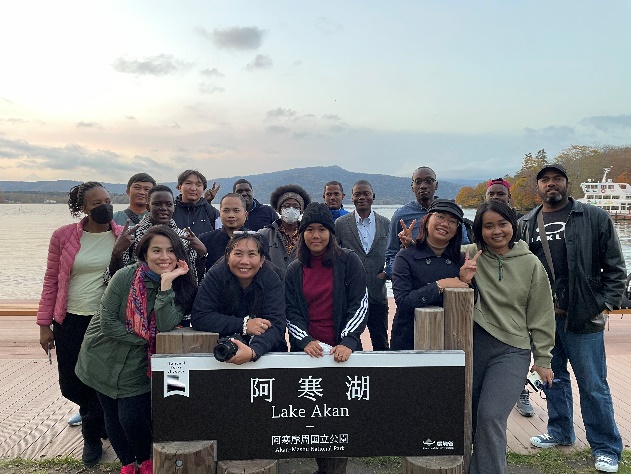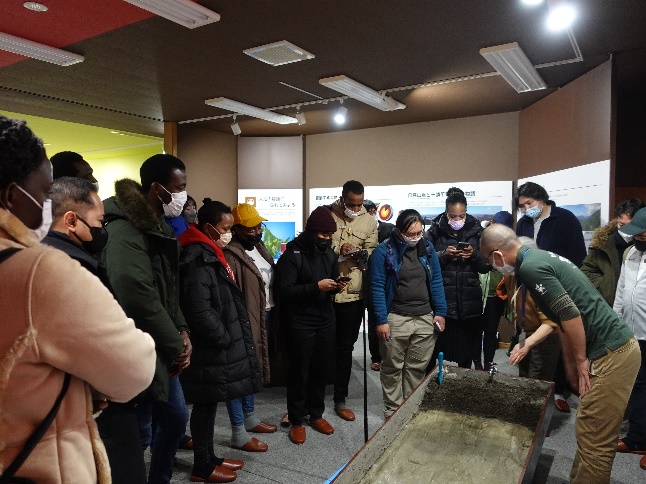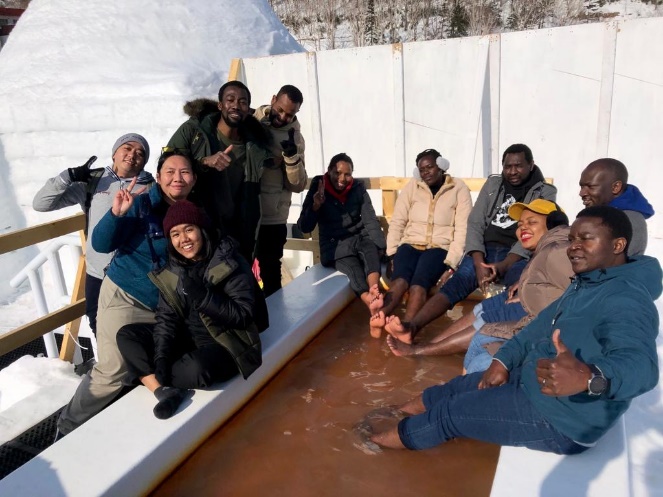The Japan International Cooperation Agency (JICA) has been welcoming international students—including administrative and technical officials—from many developing countries to Japan. These JICA scholars are people who show high potential in becoming future leaders and spearheading the development of their respective home countries. In Japan, JICA provides not only the support while they acquire new knowledge and technical skills or get a university graduate degree, but also recently organized a “Regional Understanding Program” to showcase the history of regional or local-level development in Japan, and to provide them with a hands-on experience. One of the goals of this program is to promote a deep understanding of Japan, while also providing knowledge and skills that the students could use to guide development in their own countries.
The sessions under the Regional Understanding Program took place twice at JICA Hokkaido Center (Obihiro) in FY2022. At this Institute, JICA scholars studied the history of the development in Hokkaido—Japan’s northern island—as well as its resources, culture, and industry.
1. Learning about the indigenous Ainu Culture: The development history of the Kushiro, Hokkaido area, and coexistence between the Ainu and Nature
Over two days, i.e., October 15 and 16, 2022, 17 JICA scholars participated in the Regional Understanding Program in Hokkaido. The session covered the regions of Lake Akan, the Kushiro wetlands, and other areas in the Kushiro region of Hokkaido.
Lecture about The Kushiro wetlands, and the history of the development of this region
The students enjoyed a lecture by Mr. KIKUCHI Yoshikatsu, the former executive director of the Kushiro International Wetland Center (KIWC). Mr. Kikuchi spoke about the history of pioneering and the contributions of Japanese populations from other islands of Japan within the Kushiro region, and the characteristics of the area’s natural environment. He also discussed the natural processes that led to the formation of the Kushiro wetlands, and the efforts that are being undertaken to preserve them. Moreover, he introduced the students to the culture and traditions of the Ainu society, which includes indigenous people who have co-existed with the local nature since many generations. In this manner, Mr. Kikuchi described many unique characteristics that make Hokkaido different from the island of Honshu to the south (Honshu is home to key population centers of Japan, Tokyo, the Kanto region, Osaka, and the Kansai region, as well as other important areas).
Site visit of the Lake Akan “Onnetise” and Ainu Kotan (village)
The students visited the Lake Akan Ainu Kotan, a village where many people live and continue to maintain the culture and traditions of the Ainu. They also visited the Kushiro City Ainu Culture Tradition and Creation Museum, or “Onnetise” (which means “Big House” in the Ainu language). Here, the students observed displays on the Ainu, including tools that were used for hunting and gathering practices, and goods used in their daily lives.
Before hunting, the Ainu would dedicate special prayers to their gods (Kamuy). Known as “Kamuy-no-I”, these prayers reflect the traditional way of life of the Ainu, who sought harmony and co-existence with their natural surroundings and with the other animals who lived there. “Allow us to take only those creatures and food that we need and can use, and we pray that none of the precious gifts provided to us by Heaven will go to waste or be used heedlessly.” This way of thinking is being reevaluated in modern society as well.
Afterwards, the students got a chance to create and play the traditional mouth harp of the Ainu. Called “mukkuri,” this instrument produces sounds when placed in the mouth and plucked. The students discussed similarities and differences between the Ainu culture and the ethnic-group minorities in their own countries. They also listened carefully to their guide, and practiced greetings in the Ainu language. All students showed great interest and enthusiasm during all these activities.
Visiting Kushiro City Museum
The students took a tour of the Kushiro City Museum and enjoyed the explanations provided by museum curators. They learnt a great deal about the natural ecology of the Kushiro wetlands, and the history of the development of the Kushiro region. This time, they also got to view the clothing and traditional craftwork of the Ainu people, that they had previously experienced at the “Onnetise” museum. They gained a deeper understanding of the Ainu culture.
Site visit of the Kushiro wetlands
At the Onnenai Visitor Center, which is nestled in rural surroundings, the JICA scholars walked along wooden bridges on the wetlands and enjoyed observing and learning about plants and animals inhabiting the wetlands. Their guide told them about the efforts made to preserve and protect these precious wetlands. Here, the students were able to see for themselves the animals and plants that they had learnt about at the Kushiro City Museum, including the Yezo sika deer (Cervus nippon yesoensis) and the unique yachibozu plants; a kind of sedge (Carex) (yachibozu literally means, “a boy from the valley district”!). This experience helped the students gain a practical perspective to their acquired knowledge.
Finally, at the Kushiro City Wetlands Observation Tower, the students were able to get a bird’s eye view of the wetlands and the layout of Kushiro city. Mr. Kikuchi delivered a wrap-up speech, after which the international student representatives shared their gratitude and talked about what they had learned in the program. During the ride back to their lodgings, from the bus windows, the students could see beautiful tancho ; the red-crowned crane (Grus japonensis), a nationally protected species designated as a natural treasure of Japan. The cheerful voices of these students showed their warmth and joy of having this experience.
Participants shared their experiences with their representative opinions, such as: “This was an extremely meaningful experience, as I was able to see and learn about this unique ecosystem and the local Ainu culture.” “I believe that the Ainu people have so much to teach the modern world, about how we can live in harmonious co-existence with nature and its animals and plants.”

JICA scholars visiting the Kushiro City Museum

A commemorative photograph captured at the shore of Lake Akan
2. Case study on the utilization of the natural environment for the promotion of the Tokachi, Hokkaido region: Field study at the Geopark and the Lake Shikaribetsu Kotan (village)
On March 1, 2023, a second program was organized for 16 JICA scholars in Shikaoi town and Lake Shikaribetsu of the Tokachi region of Hokkaido.
The students visited the Tokachi Shikaoi Geopark Visitor Center and the Lake Shikaribetsu Nature Center, where they learnt how the Tokachi region utilizes its abundant natural resources for community promotion.
The first site that the students visited was the Tokachi Shikaoi Geopark Visitor Center. Here, the students studied the topological formation of the Tokachi region, as well as the soil characteristics of the area. Explanations were provided about the natural environment and ecological systems that are found in this cold northern climate. In particular, the students were taught about the volcanic activity and its role in the formation of the nature and land of Shikaribetsu. The students showed a keen interest in the unique topology of Shikaoi and Lake Shikaribetsu, their soil characteristics, and the area’s volcanoes. They also asked many questions to deepen their understanding and get a holistic learning experience.
Next, the students visited the Lake Shikaribetsu Nature Center, where they learnt how the naturally formed Lake Shikaribetsu is utilized for tourism, and the ways in which the local people try to promote their region. In this cold northern district, the lake freezes in the winter. This enables local people, primarily volunteers, to construct the Lake Shikaribetsu Kotan (the term for “village” of the indigenous people of Hokkaido, the Ainu). The village is made entirely from excavated, transparent ice and fallen snow. The international students wondered how it was possible to build buildings using only ice, snow, and water, and asked many questions, which clearly indicated their surprise at this unique, “hands-on” building method.
Afterwards, the students walked on the ice in the lake, enjoyed visiting a dome-shaped igloo, and soaked their feet in a hot-spring footbath.
Several positive comments were heard from the participants. For example, one student stated, “This was a great chance to learn about the natural resources of the Tokachi area, and about the area’s development.” Another student said, “I came to know how the local people proposed ideas to use and preserve their natural environment for various activities.” One more student stressed, “I was very impressed by the strength and power of the Japanese people, who efficiently utilize their natural resources, including the lake ice, to promote tourism.”
Throughout the program, the students continuously asked questions, and expressed ideas and opinions originating from their own cultural experiences and backgrounds. This made for immensely fruitful discussions and friendly interactions.
It is anticipated that after the students return to their respective home countries, they will utilize what they have learnt and become leaders who know and are friendly with Japan and contribute to the development of their respective home countries.
You can watch the students’ visit to the Lake Shikaribetsu Kotan in the video of this Regional Understanding Program on YouTube.

JICA scholars at the Tokachi Shikaoi Geopark Visitor Center, looking at a model and listening to the explanation on the Tokachi plains’ formation processes.

Commemorative photograph of the students enjoying the hot-springs footbath at the Lake Shikaribetsu Kotan.




scroll